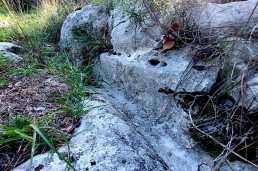Villa of the Point
The large complex, located on the island that formerly faced the mouth of the Timavo River, was investigated in the early 1970s.
It featured about 30 rooms arranged around a central courtyard.
To the north and northeast, in the residential wing, some rooms had floors decorated with black-and-white geometric mosaics; to the west was probably located the rustic part of the villa where production activities took place. The discovery of an olive press and stone elements traceable to a press seems to confirm this attribution.
A series of compartments, moreover, has been hypothetically interpreted as a thermal area. A mosaic with a central panel depicting two black dolphins facing a trident was found here.
These rooms opened onto a courtyard overlooking the lagoon; a boat was exceptionally found nearby. It, due to the construction technique employed ("mortise and tenon") was intended for use on the open sea.
Of the boat, datable like the residential building between the second half of the 1st century B.C. and the 2nd century A.D., the bottom was preserved, almost in its entirety (11 x 3.8 meters).
It is possible that it was used for the commercial distribution of the villa's products (oil, wine, fish sauces?). A number of everyday objects that were used on board were found inside the hull: ceramic vessels, a wicker basket and a wooden vessel containing grapes.
The wreck is now in the National Archaeological Museum in Aquileia.
Aquileia-Tergeste Road
This important road artery, described by ancient routes and identified by some scholars with the via Gemina, crossed the area between the Soča and Timavo rivers to head towards Tergeste (Trieste) and toward Pola in Istria.
From Aquileia it passed through the territory of San Canzian d'Isonzo and then in the vicinity of the villa of Staranzano; it joined other roadways near present-day Ronchi dei Legionari where a bridge over 200 meters long crossed an ancient riverbed of the Isonzo. The road then ran at the foot of the southern slope of the Monfalcone hills and continued toward Tergeste after crossing over a stone bridge over the Locavaz River. At the mouth of the Timavo was the Randaccio villa, which served as a rest station for travelers (mansio). Numerous sections of the road have been identified in the course of archaeological research and through the use of aerial photography; the discovery of funerary monuments, usually placed, in Roman times, along the road axes, has contributed to the reconstruction of the ancient road network in the area.







